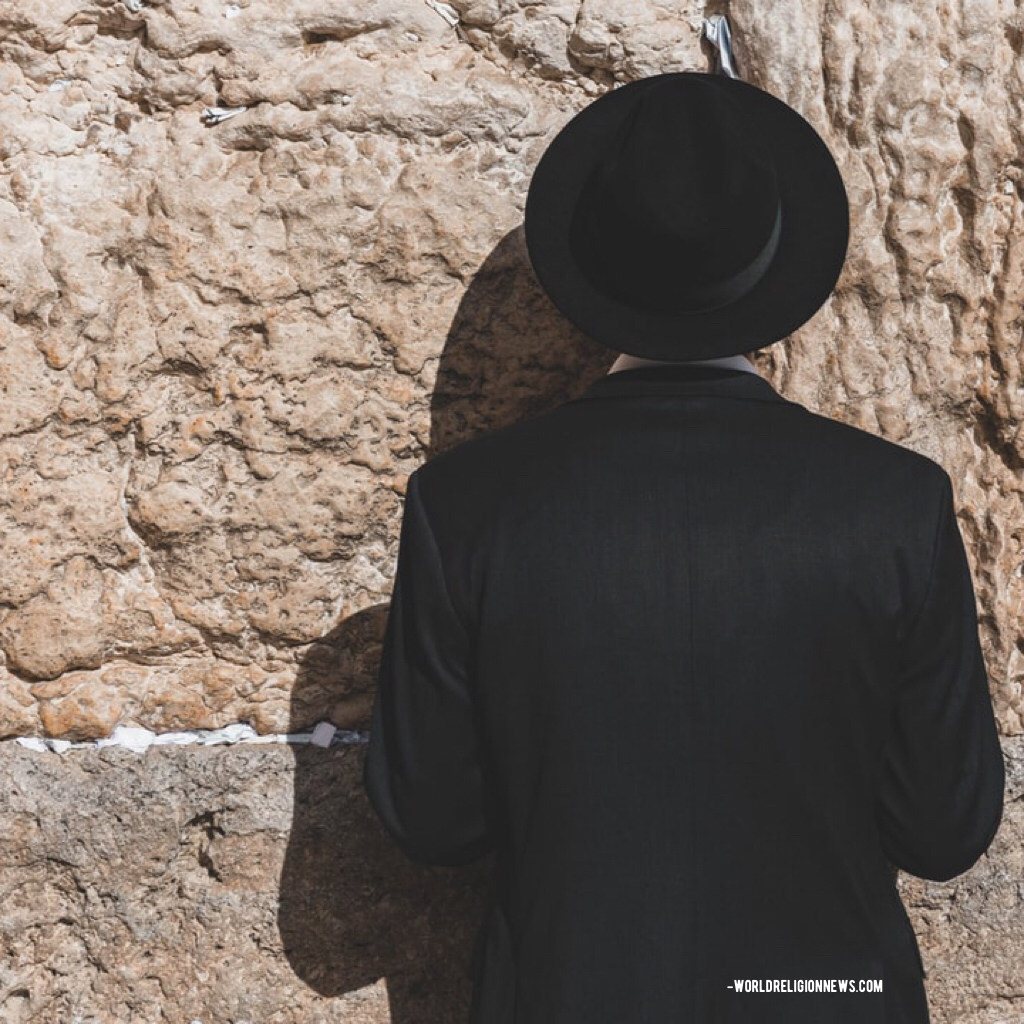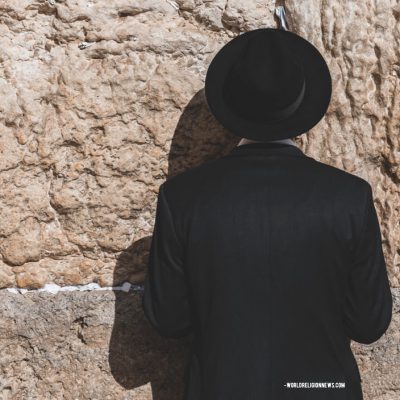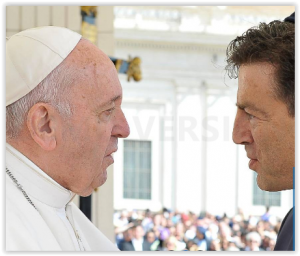
Yom Kippur and You: An Interview with Rabbi Ron Li-Paz
- By Sam Field --
- 09 Oct 2019 --
 For those not raised Jewish, the High Holy Days may seem confusing or strange, something from another time and place. But according to Rabbi Ron Li-Paz, there are concepts in Judaism which all people may find useful and relevant in today’s world. Rabbi Li-Paz is the Spiritual Leader of the Valley Outreach Synagogue in Calabasas, Calif., near Los Angeles. He previously served in the U.S. Air Force in England, completed a bachelor’s degree with the Royal Academy of Dramatic Art in London, worked for the BBC, and as a management consultant. He is a professional singer and sang the national anthems of Israel and the United States in front of President Obama and Prime Minister Netanyahu. He was ordained in 2013 and earlier this year he was honored as a special guest of Pope Francis at the Vatican.
For those not raised Jewish, the High Holy Days may seem confusing or strange, something from another time and place. But according to Rabbi Ron Li-Paz, there are concepts in Judaism which all people may find useful and relevant in today’s world. Rabbi Li-Paz is the Spiritual Leader of the Valley Outreach Synagogue in Calabasas, Calif., near Los Angeles. He previously served in the U.S. Air Force in England, completed a bachelor’s degree with the Royal Academy of Dramatic Art in London, worked for the BBC, and as a management consultant. He is a professional singer and sang the national anthems of Israel and the United States in front of President Obama and Prime Minister Netanyahu. He was ordained in 2013 and earlier this year he was honored as a special guest of Pope Francis at the Vatican.
The High Holy Days began this year with Rosh Hashanah on the eve of Sept 29, and ended 10 days later with Yom Kippur. Rabbi Li-Paz was kind enough to take time from Yom Kippur preparations to talk to World Religion News about the High Holidays as celebrated in the Jewish tradition.
World Religion News: Yom Kippur is a ‘Day of Atonement’ of prayer and amends for past misdeeds. How is this accomplished, through confession, or a listing of transgressions?
Rabbi Li-Paz: There isn’t a confession in our tradition, as there might be in a church with a priest. What we have is a communal confession. Most Jewish prayer is in the plural. So we don’t pray for the salvation of our souls, as individuals, we pray for the salvation of the world. We don’t confess our individual sins, we say a litany of sins that we as a community and as a people are surely responsible for.
One of the ideas behind this is contrition. So how do you know when the person actually performs Teshuvah [repentance] fully? When he goes back to the scene of a previous temptation where he sinned, is confronted by the same temptation, and chooses a different outcome. Intention is one thing, prayer is one thing, but it really has to translate into our actions.
World Religion News: How might the principles of Yom Kippur be relevant to non-Jewish people?
Rabbi Li-Paz: Our new year which we celebrated just 10 days ago, Rosh Hashanah, is not the birth of a Savior, a Messianic figure, and not even the birth of Judaism with Abraham. It is the birth of the world. So we are recognizing the birthday of God’s creation – all people, all faiths, all traditions, all cultures in the world. That’s one unifying thought.
All of us can all learn from each other’s religions in how to deepen our thinking, how to improve the quality of our prayer life, how to reach greater levels of spirituality.
All prayers are seen as an experience of holding mirrors up to ourselves and our souls. I think that applies to anybody who chooses to look at prayer that way. I think of a prayer book as a book of mirrors. Every prayer, every page is asking me to find myself reflected in it. The word ‘to pray’ is a reflexive verb in Hebrew – it’s something you do to yourself, which means it’s reflecting on who you are, judging your life in that moment. And I think that’s something we can all benefit from.
Atonement and contrition are about being better human beings the next day or the next moment. Not merely to our own community, but to one another, and I think we would do well to learn from that wisdom in any of the great traditions of the world. Anything that will unify us and help us to see God’s light in every single person. We say that all human beings – not just Jews, or Christians or Muslims, but all people regardless of their faith – are created in the Divine image.
World Religion News: Jews, Christians, Muslims, and the conflicts of people of faith – is there a way forward? Do you see hope in that direction?
Rabbi Li-Paz: Very much so, and I don’t mean hope in an idealistic, Pollyannish point of view. The reason I’m hopeful is that if we each look to the wisdom in our traditions, we’ll see our obligations to one another. One of the lessons I’ve had in the last year – in meeting and blessing Pope Francis, or being in Muslim-majority Azerbaijan, experiencing Ramadan with Muslims in Los Angeles, or engaging with Christian clergy here in the city – is we have to move closer to each other. There’s no way to really care enough about each other at a distance. We have to get close enough to see the color of each other’s eyes, and then we’re engaged with who the person is, and our unifying story, what it means to be human, to be people struggling and striving – which are all of us in this world.
World Religion News: What will happen at sundown this evening for the members of your synagogue as Yom Kippur begins?
Rabbi Li-Paz: People traditionally wear white and not leather, as two examples. Why not leather? So that we’re not in comfort on the back of something that suffered – those animals that die so we can wear beautiful leather shoes and belts. White is a symbol of purity, but we don’t only wear white, we wear a kittel, which is a shroud, a death garment. And it’s meant to awaken us to our own mortality and create an urgency in our apologies to God and the people around us, and an urgency in our forgiveness of the people in our world and in our lives.
We will gather tonight for a haunting prayer called Kol Nidrei, and then go into a beautiful evening service for the Holy Day of Yom Kippur. From sunset no food or drink unless the person is ill, and we won’t eat or drink again until the end of the holiday tomorrow.
World Religion News: You had a career in the U.S. Air Force, were involved in music and theatre. What made you decide to become a Rabbi?
Rabbi Li-Paz: I was offered the opportunity to sing in the synagogue, and it was a job rather than a calling – or maybe a calling I didn’t yet recognize – to be a cantor, to sing. And as I learned more and studied, to be able to do what I was doing with integrity, I took more interest in the ideas and wisdom of the religion and then decided to deepen my learning with five years of study to become a Rabbi.
 World Religion News: You met with Pope Francis earlier this year. How did it come about and what did you learn from the experience?
World Religion News: You met with Pope Francis earlier this year. How did it come about and what did you learn from the experience?
Rabbi Li-Paz: I was invited by a colleague, Bishop Juan Carlos Mendez, president of Churches in Action. He and I were at a delegation at Baku, Azerbaijan. He said: ‘I’d like to introduce you to the Holy Father, would you come with me to Rome?’ I was beyond honored, to not only be in the presence of the Pope, but to have been one of three special guests at the Vatican that day, and to have stood and spoken with him, shared blessings with him, on St. Peter’s Square.
Aside from the great honor to stand next to the leader of the Catholic faith, the leader of a billion people, the image of Rabbi and Pope standing in an embrace, in conversation and prayer was being broadcast on giant screens on the Piazza, on St. Peters Square, and that image has been seen all over the world in print and on the Internet. Maybe a picture can not only speak a thousand words, but can change a thousand hearts or even more. It was far greater than just a personal experience for me, if one person looks at that as what might be in the world and that differences are far less important than what binds us – our values, our ethics, our morality and our wishes for the world.


















